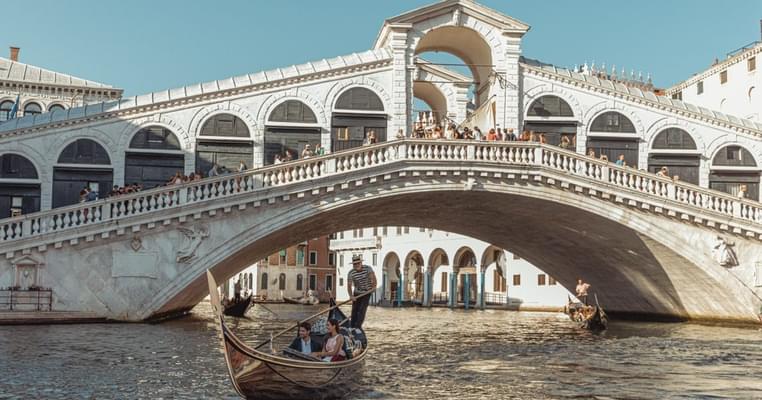How Did Gondola’s Originate?
There seems to be some sort of cloud over the gondola's true beginnings as far as Venice Gondola history is concerned. Different countries lay claim to being the gondola's place of birth; these include Italy, Turkey, Greece, and Malta. The Doge (leader) of Venice, Vitale Faliero, referenced a Gondola in a letter to the people in 1094, which is when the first rumors began to spread. To head off any sort of uprising, he 'gave' the locals gondola-like boats, telling them they would make getting around town a breeze.
Carpaccio and Bellini, two famous artists from the 1400s whose paintings have survived to the present day, created the earliest known depictions of a gondola. Gondola’s construction and use in Venice's waterways did not begin until the 16th centuries and its appearance was quite different from how they do now. Most of the town's upper class rode in gondolas, which were decked up in lavish ornamentation for their exclusive use. All private gondolas were required by law to be painted black by the Italian government in the 16th century, and this tradition persists to this day for the sake of uniformity.
As the Italian Renaissance came to a close in the 17th century, the city's waterways were populated with an estimated 9,000 gondolas. Over the years, their design has been improved to better serve as passenger vehicles or water taxis, as they are also known, in a metropolis where the ocean flows through, rather than around, it. These days, nearly all of Venice's roughly 400 gondolas look the same.
The Workings of a Gondola
Building a gondola from scratch takes around two months, and only those who have perfected the technique and adhere to a rigid code called the ‘mariregole’ can build it. There is a startling degree of uniformity between the gondolas with each being around 600 kilograms in mass, and 11 meters in length. Boats in Venice are custom-made to fit the city's intricate network of waterways and low footbridges.
Each gondola is uniquely crafted using eight different types of wood: mahogany, walnut, elm, birch, lime, cherry, and larch. They all work together to keep the boat afloat and allow it to carry as much weight as possible. The gondolier stands 9 inches off center, so the port side is larger and higher than the star board. The ferro, a heavy metal bar mounted to the bow of the gondola, serves as the gondolier's counterbalance. It serves a dual purpose of keeping the gondola's platform above the water. The walnut forcola is curved and equipped with multiple hooks for the oar, so it can be adjusted to the gondolier's preference while rowing. Gondoliers use the forcola to generate 'C' or 'J' shaped strokes that keep the boat from spinning.
Brief History of The Gondola
1094In a letter sent in 1094, a representative of the Venetian Republic makes reference to a vessel known as a gondola.
1490sAs early as the 1490s in Venice Gondola history, Italian artists Carpaccio and Bellini depicted gondolas in their works. The kind of rowing seen is quite similar to that practiced by modern gondoliers.
1500sDuring Venice Gondola history’s Baroque era of the 1500s, gondolas were designed with elaborate decorations. The rocker at the bottom of a gondola was increased and the stern was made wider to improve the boat's stability and the gondolier's line of sight.
1600sDuring the 1600s, the number of gondolas in Venice increased dramatically, with some estimates placing the number at 10,000.
1768In 1768, a naval artist created a detailed blueprint of a gondola's design. Based on the Venice Gondola Rides history facts, you may deduce that the 18th-century gondola is nearly identical in size to the gondolas rowed today; the only difference is that the design has remained symmetrical.
end of the 1800sVenice Gondola history has it that during the late 1800s, gondoliers had perfected the design of the gondola by adding an asymmetrical feature. Steam-powered boats arrive in Venice just as the gondola reaches its pinnacle of perfection, and gondolas' once-popularity starts to decline.
2000John Kerschbaum launched his first genuine gondola on the Stillwater, Minnesota, waterways in the year 2000.
2001In 2001, Gondola Romantica/Gondola on the St. Croix started taking couples out on the St. Croix River in Stillwater.
2001+The historic and romantic gondola cruise will take you to the far distance till the midwest starting from the Venetian waterways of Italy.
FAQs
When have gondolas been used in Venice?
Gondolas were already in use as early as the eleventh century. Designed specifically for the shallow lagoon waters of Venice, their use dates back to at least the 11th century (perhaps earlier) and is first attested in 1094.
What was the gondola first used for?
As per the Venice Gondola history, it was first used for transportation around Venice’s canals.
Must Checkout: Things To Do in Florence With Kids
Why does Venice have gondolas?
Venice has gondolas because they are the typical mode of transportation in the city. They were necessary since there were no roadways for people to ride horses on, and the canals were too wide for smaller boats.
Also Checkout: Things to do in Rome
What time do gondola rides start in Venice?
Gondola rides run every day of the week, often from 11 AM to 7:30 PM.
Must Check: Day Trips From Rome
Where's the best place to get a gondola in Venice?
The best place to get a gondola in Venice is at the gondola dock in St. Mark's Square, the city's central plaza.
Also Book: Castel Sant Angelo Tickets

